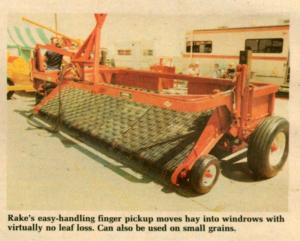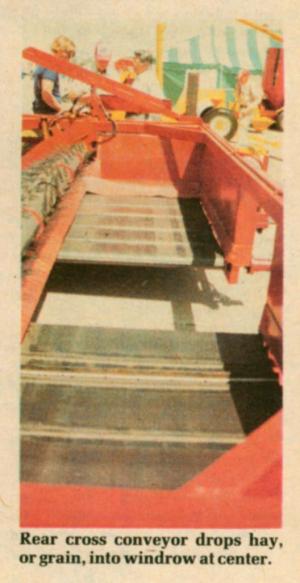1986 - Volume #10, Issue #4, Page #16
[ Sample Stories From This Issue | List of All Stories In This Issue | Print this story
| Read this issue]
Conveying Hay Rake First Of Its Kind
 |
 |
It's equipped with nylon "fingers" which pick up the crop in the same fashion as.a combine pickup attachment. The front belt conveyer drops the crop on a rear cross conveyor which discharges it center, left or right.
"There isn't a rake on the market that can match it for gentle handling of the crop, and its ability to salvage crops which have been pounded flat into the ground by wind or rain," says Rowse who feels his new-style rake opens the gate to "making top-quality hay the old fashioned way.
"You cut the hay with a sickle-type mower, allowing it to cure in the swath without mechanical crimping or conditioning, both of which cause nutrient-laden juices to leak out and be lost. Because it's in the mowed swath, it's cured naturally by the sun in a matter of hours. When cured, you move in with the Conveyor Rake to windrow the hay with virtually no leaf loss," explains Rowse. With a front-mounted unit, you can windrow and bale in one operation.
"It's the old fashioned way to make hay ù but without leaf loss, a feature which sets our Conveyer Rake apart from conventional dump, reel or basket type hay rakes," Rowse points out.
He also envisions using the new-style rake for harvesting small grains. "You mow the crop with a sickle-type mower, let it dry in the swath, then windrow and harvest," he points out.
Rowse feels the new rake, teamed with the company's full line of sickle-type mowers, sets the stage for "an exciting new future." The company offers trailing and 3-pt. "pitmanless" sickle-type mowers with single or double bars (up to 18-ft. swath).
In addition to placing swathed crops into windrows without loss of leaves or grain, the Conveyer Rake can be used to work problem crops. For example, if windrowed hay can't dry, the rake can be used to lift the windrow, fluff it, then deposit it on dry ground. Downed crops can be cut, then windrowed into harvesting form. The rake can also be used to combine two or more windrows into one.
Available in either pull-type or front-mounted models in 10, 12, 14 or 16-ft. units, all of which can be doubled up. Transport width is 8 ft.
For more information, contact: FARM SHOW Followup, Rowse Mfg., Burwell, Neb. 68823 (ph 800 445-9202 or 9203; in Nebraska, call 800 652-1912).

Click here to download page story appeared in.

Click here to read entire issue
To read the rest of this story, download this issue below or click here to register with your account number.




